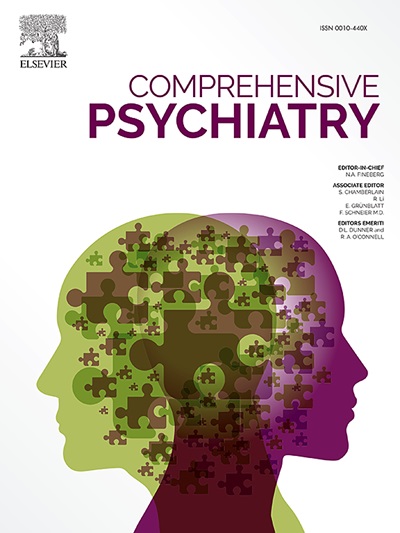Olfactory reference syndrome: A nosological conundrum?
IF 4.2
2区 医学
Q1 PSYCHIATRY
引用次数: 0
Abstract
Background
Individuals with olfactory reference syndrome (ORS) erroneously believe that they have unpleasant body odour or halitosis, often leading to compulsive washing or toothbrushing, self-consciousness, and social withdrawal [3], symptoms shared with obsessive-compulsive disorder (OCD) and social anxiety disorder (SAD) [1,2,4], respectively. ORS is classified as an ORCD, but the literature on comorbidity of ORS with OCD and SAD is sparse. We therefore examined ORS's prevalence in people with OCD and/or SAD.
Methods
In a South African clinical sample (n = 371; male = 164 [44.2 %], female = 207 [55.8 %], mean age: 32.3 [SD: 11.5 years]), ages ranging between 14 and 64 years), rates of ORS in people with primary OCD without SAD (OCD-SAD; n = 211) were compared using a chi square test with those with primary SAD without OCD (SAD-OCD; n = 118), and those with both OCD and SAD (OCD + SAD; n = 42). The study was formally approved by the research ethics committee of Stellenbosch University (reference number: 99/013). All participants provided written informed consent prior to participation in the study.
Results
In the combined dataset, ORS rates were low (n = 6/371; 1.6 %). There were significantly higher rates of comorbid ORS in the SAD-OCD group (n = 5/118; 4.2 %) compared to the OCD-SAD patients (n = 0/211; p = .005) and OCD + SAD (n = 1/42; 2.4 %; p = .022), with no significant difference between OCD-SAD and OCD + SAD (p = .677).
Conclusion
Our findings suggest a stronger link between ORS and SAD than between ORS and OCD, which may have nosological implications. Further research on the psychobiology and management of ORS may be useful in determining whether it is more closely related to SAD or to OCD.
Funding
This work has not been funded specifically. The authors are supported by the South African Medical Research Council.
嗅觉参照综合征:一个病分学难题?
嗅觉参考综合征(ORS)患者错误地认为自己有难闻的体味或口臭,往往导致强迫性洗涤或刷牙、自我意识和社交退缩,这些症状分别与强迫症(OCD)和社交焦虑症(SAD)相似[1,2,4]。ORS被归类为ORCD,但关于ORS与OCD和SAD合并症的文献很少。因此,我们检查了ORS在强迫症和/或SAD患者中的患病率。方法1例南非临床样本(n = 371;男性 = 164[44.2% %],女性 = 207[55.8% %],平均年龄:32.3 [SD: 11.5 岁]),年龄范围为14 ~ 64 岁),原发OCD无SAD患者的ORS发生率(OCD-SAD;n = 211)与原发SAD无OCD (SAD-OCD;n = 118),同时患有强迫症和SAD的患者(OCD + SAD;n = 42)。本研究得到了Stellenbosch大学研究伦理委员会的正式批准(参考编号:99/013)。所有参与者在参与研究前都提供了书面知情同意书。结果在合并数据集中,ORS率较低(n = 6/371;1.6 %)。SAD-OCD组共病ORS发生率显著高于对照组(n = 5/118;4.2 %)与OCD-SAD患者相比(n = 0/211;p = .005)和OCD + SAD (n = 1/42;2.4 %;p = .022),OCD-SAD与OCD + SAD无显著性差异(p = .677)。结论我们的研究结果表明,ORS和SAD之间的联系比ORS和OCD之间的联系更强,这可能具有分科意义。对ORS的心理生物学和管理的进一步研究可能有助于确定它与SAD还是强迫症的关系更密切。这项工作没有得到专门的资助。作者得到了南非医学研究理事会的支持。
本文章由计算机程序翻译,如有差异,请以英文原文为准。
求助全文
约1分钟内获得全文
求助全文
来源期刊

Comprehensive psychiatry
医学-精神病学
CiteScore
12.50
自引率
1.40%
发文量
64
审稿时长
29 days
期刊介绍:
"Comprehensive Psychiatry" is an open access, peer-reviewed journal dedicated to the field of psychiatry and mental health. Its primary mission is to share the latest advancements in knowledge to enhance patient care and deepen the understanding of mental illnesses. The journal is supported by a diverse team of international editors and peer reviewers, ensuring the publication of high-quality research with a strong focus on clinical relevance and the implications for psychopathology.
"Comprehensive Psychiatry" encourages authors to present their research in an accessible manner, facilitating engagement with clinicians, policymakers, and the broader public. By embracing an open access policy, the journal aims to maximize the global impact of its content, making it readily available to a wide audience and fostering scientific collaboration and public awareness beyond the traditional academic community. This approach is designed to promote a more inclusive and informed dialogue on mental health, contributing to the overall progress in the field.
 求助内容:
求助内容: 应助结果提醒方式:
应助结果提醒方式:


